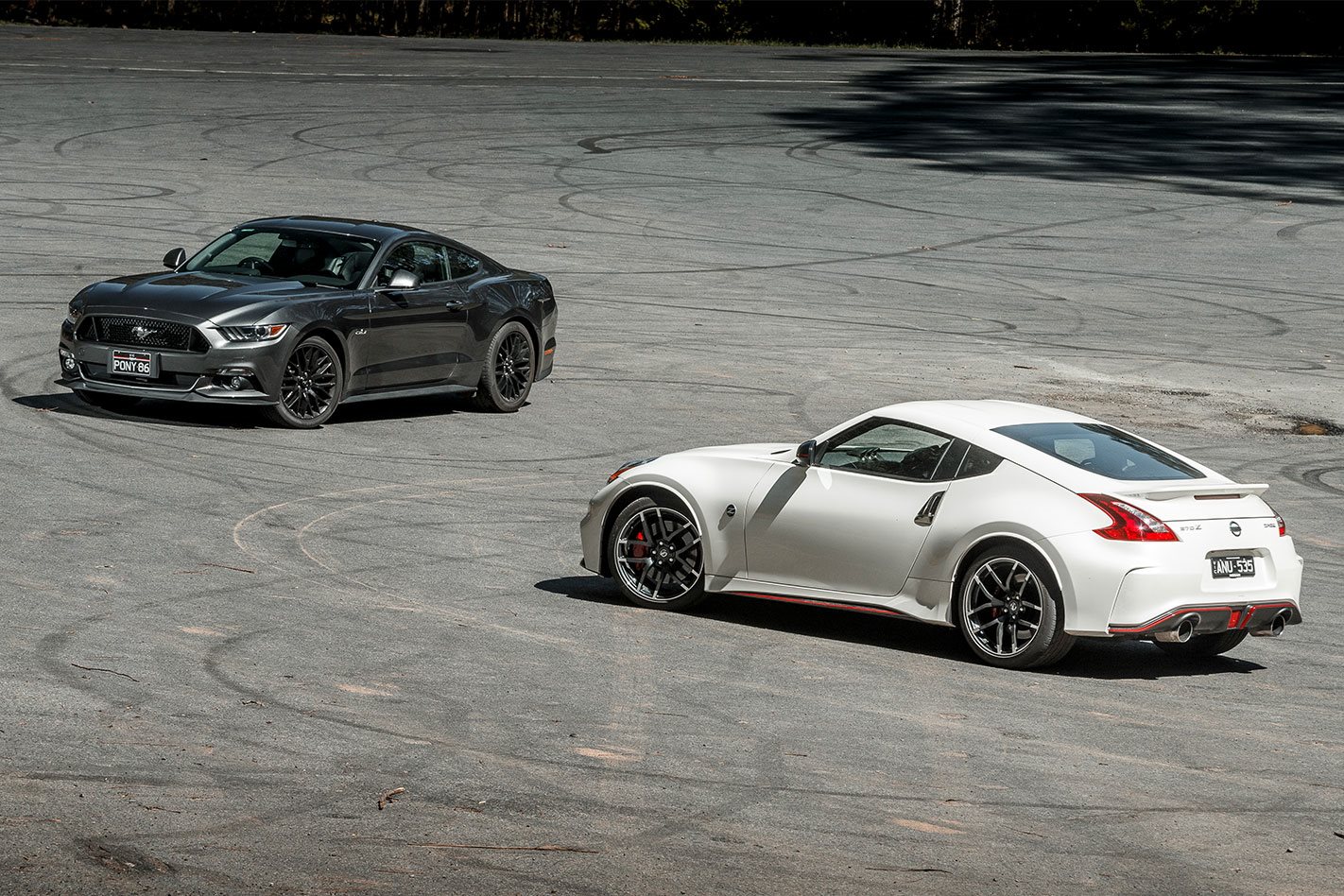Grandma gets a few things wrong in her old age. Like which end to speak into an iPhone, avoiding your foot in her mobility chair, or throwing out your “very important” magazine collection. However, saying “stick to your roots” is a slice of wisdom that’ll ring true until John Farnham retires.
Take this pair. On one hand we have Ford’s Mustang. It’s as American as a Big Mac and has sold in big numbers. Since 1964, more than nine million have been built, and in its sixth-generation, Aussies have finally been granted a taste.
Those retro, muscular lines have mesmerised local Ford fans, and a 5.0-litre V8 packing more than 400 horses helps. In its first full year on sale, the Mustang bolted to best selling ‘sports’ car success, even eclipsing the four-door Falcon in its final year.
But it’s been decades since anyone’s gushed about a new Mustang. There have been three, maybe four, Americans would rather forget. Today, though, it’s as if the Mustang’s roots were spliced into the brains of everyone who created the new S550. Loaded with grunt, the right looks, independent rear suspension, and an affordable price of less than $60K, all it lacks is some competition. Until now.
With HSV yet to officially confirm the Camaro, and our home-grown heroes gone, the Nissan 370Z is all that’s left to keep Ford’s runaway honest. It’s in the same ballpark for price, but how does a seven-year-old car pick a fight with one almost brand new? It comes down to that badge. Nissan used to let its motorsport arm go nuts on road cars from time to time, then it began on full-time specials in the late-Noughties, but we’ve had to watch everyone else enjoy them until Japan greenlighted the GT-R and 370Z Nismos for Aussie tarmac earlier in 2017.
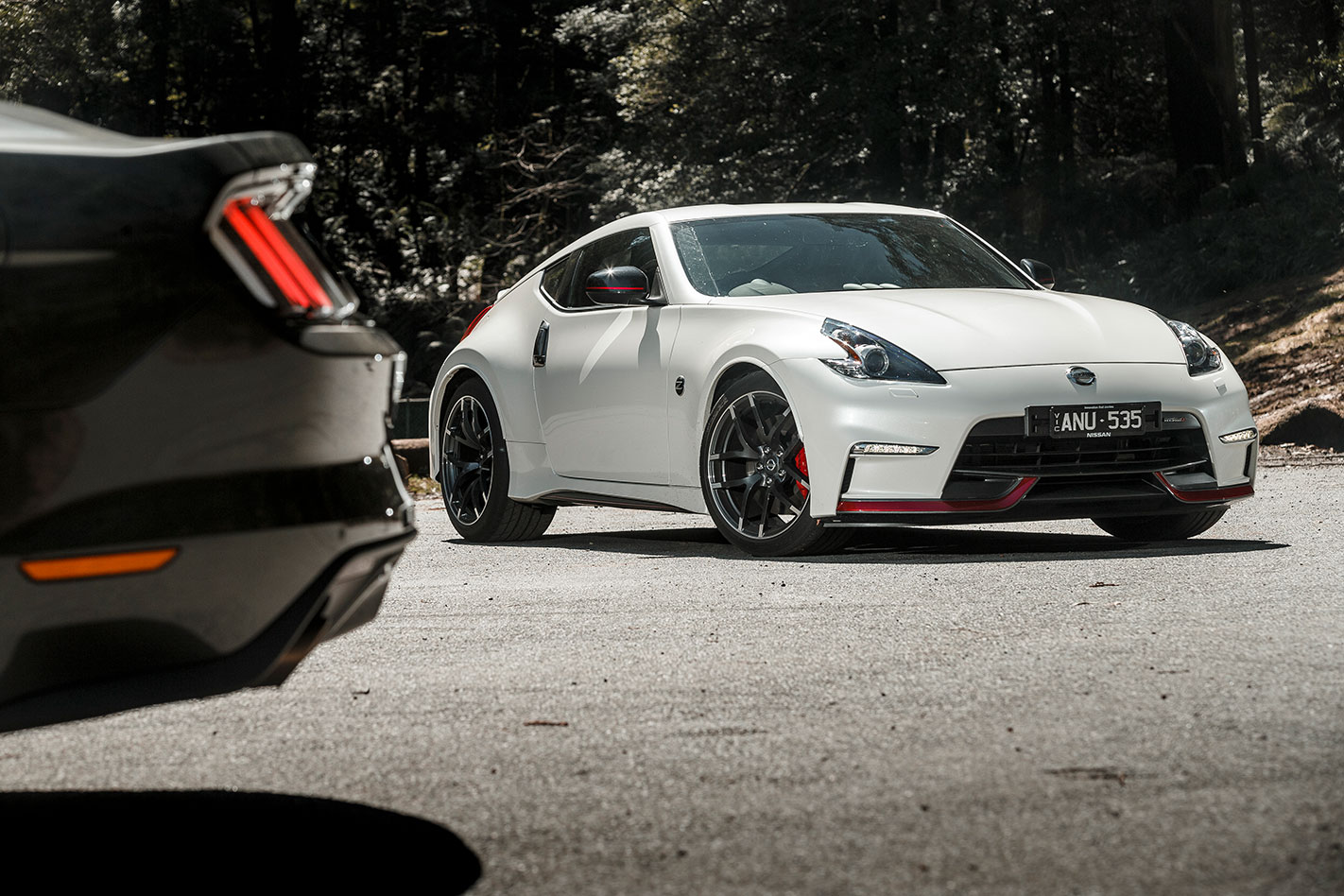
Not that the Mustang is intimidated. People smile and point at it more often than the less iconic Nismo, and multiple creases and sharp lines make it an aggro-looking thing. It’s also much bigger, wearing 19-inch wheels on a longer wheelbase, while its hips bulge out over a wider rear track.
Looks aside, when it comes to drag races the Nismo slaps on the table a 3.7-litre V6 that runs a high 11:1 compression ratio, double overhead cams, oversquare bore-to-stroke ratio and valve lift on intake cams. The Nismo badge brings with it a cat-back exhaust system that better separates gases from each cylinder bank all the way to the tips, while fiddled spark and timing eke out a total of 253kW and 363Nm.
Ford Mustang Ecoboost vs Toyota 86
Aussies have met the Mustang’s 5.0-litre Coyote V8 before (albeit at the core of FPV’s supercharged Miami engine). Carried over from the fifth-gen car, its cylinder heads feature larger valves, stiffer springs, and tubular exhaust manifolds to trample the Nismo with outputs of 306kW and 530Nm.

The story changes at the first gearshift. While the Nismo’s six-speed doesn’t like being rushed, as the revs tend to hang for a moment once the clutch is dipped, the Mustang’s relishes the grunt work. So 70km/h to 80km/h with a first-to-second change takes five tenths compared to seven in the Nismo.
A difficult launch and lazy synchros bump the Mustang’s sprint to 100km/h above five seconds, but beyond this speed it’s a force. That Coyote pulls harder the higher it revs, breathing deep and thundering towards its 7000rpm redline with ease. At the 400m finish line the Driftbox flashes 13.32sec at 176.56km/h.
The Nismo, meanwhile, is cursed by longer gearing. Sure, a second-to-third shift at 110km/h helps it snare 100 clicks in 5.69sec, but it only just needs fourth before the quarter mile, whereas the Mustang passes 400m with less than 750rpm to spare in its fourth cog.
Now, more time in gear would be fine if the 370Z sounded like a GT-R Nismo’s baby brother. From the outside it growls with a deep, meaty note, but inside fails to drown out the synthetic engine noise being plumbed through the speakers. Sure, the Mustang’s no Italian symphony, but its rumble is honest, deep, and builds into a heady buzz that’ll have you shifting down much more often. Ultimately, it’s aurally pleasing.
Go searching for a buzz on twisty stuff in Victoria’s rolling hills and the Mustang acquits itself well for a 1700kg lump. Those Brembos feel over-assisted at low speeds but work better at a higher pace, the front-end sniffs out apexes with surprising turn-in and the front-end feels connected despite a bonnet longer than a speedboat’s. You’d fall out of this thing mighty impressed after a back-road blat… if the Nismo wasn’t waiting for you.
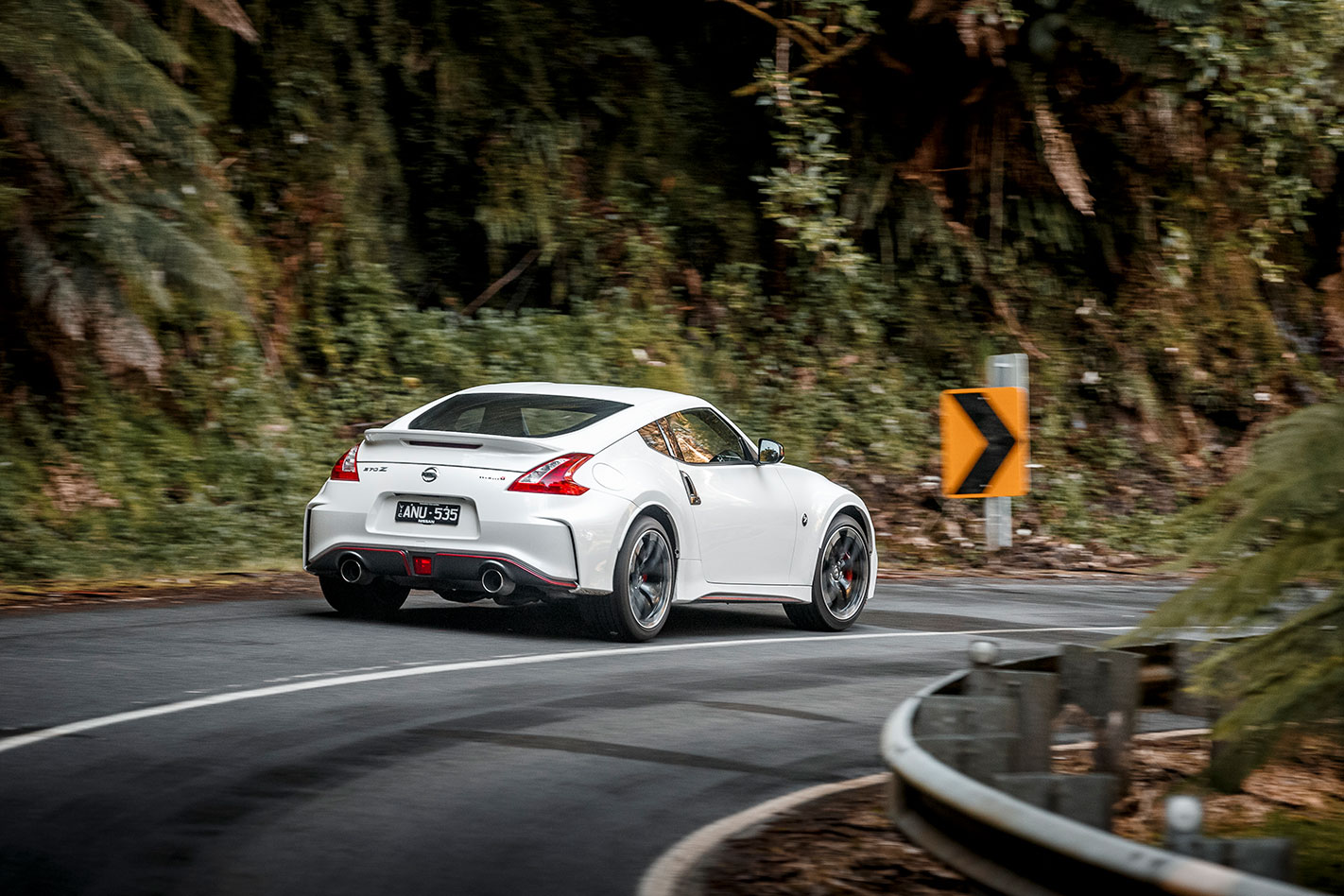
In contrast, the Mustang feeds you little information through its seats, tiller, and pedals. As you start to nudge its limits, the longer wheelbase gives you an earlier warning than the Nismo when things are about to come round, but you seem to watch it happen rather feel it.
Add a bit of grease, or water, into the mix and the Mustang’s rear-end just doesn’t hold the road well enough for a 530Nm rear-driver. Even with an 8.8-inch rear LSD, multi-link rear setup and 53:47 weight balance, where the Nismo has you hooking into corners you’re instead slowing down inputs in the Mustang to bring its physics into check.
That said, the Nismo’s not perfect. While the speed-sensitive steering relays huge amounts of information about available grip, and controls an obedient front-end, it’s not extremely accurate mid-corner. And while you can sense the rear moving, its stumpy wheelbase and firm suspension means it can swap ends quicker than a drift trike. The viscous LSD, too, can get a bit lazy and let the inside rear spin up.

Even the 370Z’s interior is more suited to this drama. You climb in over heavily-bolstered Recaros, dab nicely staggered pedals and grab a well-placed shifter. Its brakes need a firmer squeeze to chomp with the same bite, but they have a nice progression provided you’re not into the anti-lock. The transmission, at least in this setting, also doesn’t baulk like the Mustang’s on every shift, either.
The Mustang’s cabin isn’t so stimulating. The dashboard’s shape is a charming nod to the original car, but the brushed silver inserts, faux-chrome controls, and sea of black produce an uninspiring workstation. It is, at least, comfortable. There’s acres of space under the dash to swing your knees and you can mould into a perfect driving position thanks to electric seats and adjustable steering rake.
The Nismo’s interior, lashed with red and Alcantara, has the glow of a beachside night club, but it’s less charming to live with daily. You’d have better luck finding the Titanic than the Bluetooth menu, and we don’t understand why the Recaro seats don’t have a quick release function to fold forward. Small and baulky items are instead thrown in the boot. We can see why Nissan thought linking the dash with the steering column was a good idea – it keeps the dials visible – but we struggle with why the cruise control buttons press the horn. As will other motorists. Meanwhile, in the Mustang interior, door operation is simple, the vents are within reach, and button functions are easily interpreted. The Sync 3 infotainment system features Apple CarPlay, and the front seats fold forward, allowing access to the rear.
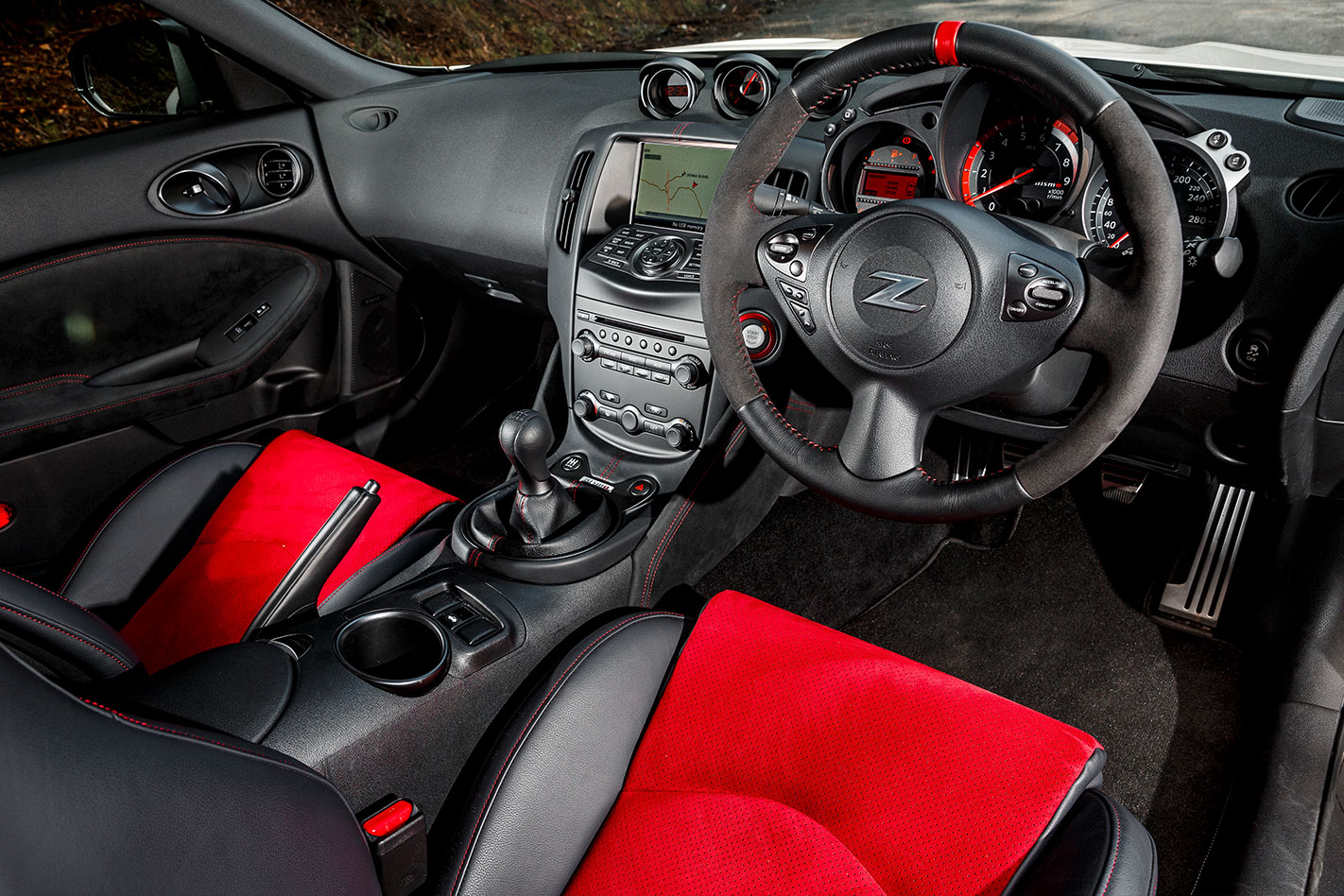
Sure, the Nismo’s body control is tight and it’s allergic to roll, but it just can’t hide from its short damper travel. Its secondary ride improves at more than 100km/h, but at less than that the Nismo would rattle out your granny’s teeth. Oh, not to mention the tyre noise would send her hearing aid into meltdown.
So while the Nismo’s ride is not one-dimensional, it’s simply unacceptable, motorsport-inspired or not. When Honda is delivering a hatchback on 20-inch wheels that rides with the sophistication you’d come to expect from Porsche for about $10K less, it signals the game has moved on. That said, we love that the gear shift and steering are a bit of old-world charm in today’s marketplace. But the Nismo can only shine in very specific conditions and its engine acoustics are unforgiveable. Further weakening its case is the fact its arrival has pushed down the base car’s price to $50K. While you’d struggle to rustle wheels, tyres, body parts, dampers, braces, and an exhaust for the Nismo’s $10K extra ask, the base car’s ride, or noise, can’t be any worse. And it packs only 8kW less.
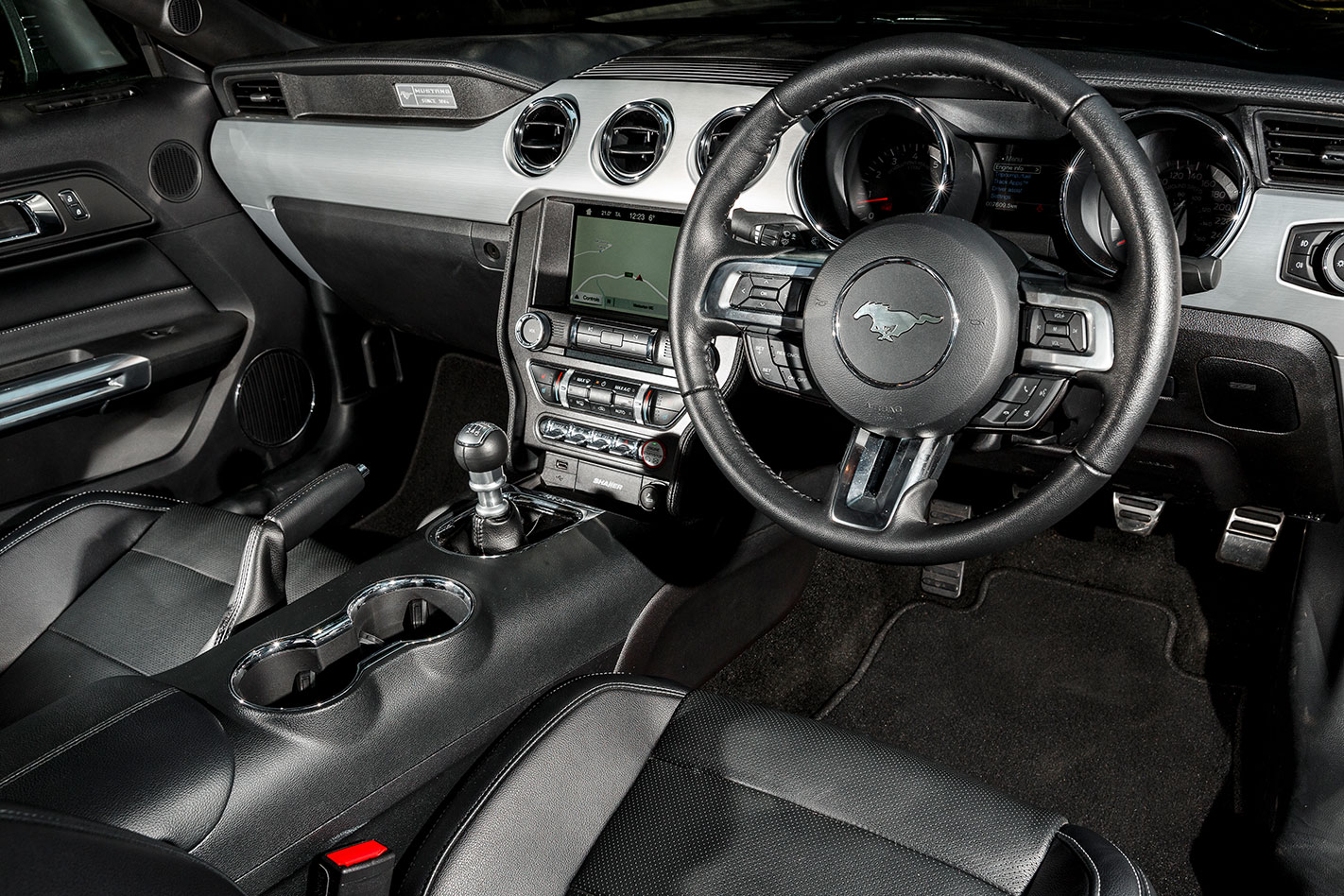
On the other hand, the 370Z’s future isn’t so bright and executives haven’t committed to a replacement. Nissan didn’t even drop a concept, as expected, at the recent Tokyo motor show.
Ford blew everyone away with its sixth-gen ’Stang, showing there’s a global appetite for a throwback to a legend. It’s time for Nissan to follow Ford’s lead, like in the ’60s, and refresh the Z with something great like the original. Something to make Granny proud.
The Numbers:
Ford Mustang GT | Nissan 370Z NISMO |
0-10km/h 0.42sec | 0-10km/h 0.40sec |
0-20km/h 0.90sec | 0-20km/h 0.84sec |
0-30km/h 1.31sec | 0-30km/h 1.25sec |
0-40km/h 1.79sec | 0-40km/h 1.67sec |
0-50km/h 2.20sec | 0-50km/h 2.19sec |
0-60km/h 2.64sec | 0-60km/h 3.04sec |
0-70km/h 3.34sec | 0-70km/h 3.57sec |
0-80km/h 3.86sec | 0-80km/h 4.26sec |
0-90km/h 4.48sec | 0-90km/h 4.96sec |
0-100km/h 5.27sec | 0-100km/h 5.69sec |
0-110km/h 6.06sec | 0-110km/h 6.85sec |
0-120km/h 6.86sec | 0-120km/h 7.84sec |
0-130km/h 7.73sec | 0-130km/h 8.87sec |
0-140km/h 8.67sec | 0-140km/h 9.92sec |
0-150km/h 9.91sec | 0-150km/h 11.53sec |
0-160km/h 11.12sec | 0-160km/h 13.06sec |
0-170km/h 13.83sec | 0-170km/h 14.61sec |
0-400m | 0-400m |
80-120km/h (3th-6th) 3.2/4.3/6.3/12.8sec | 80-120km/h (Drive) 4.0/5.3/7.2/10.7sec |
100-0km/h 34.59m | 100-0km/h 33.68m |
SPEED IN GEARS | SPEED IN GEARS |
1st 71km/h @ 7000rpm | 1st 69km/h @ 7500rpm |
2nd 107km/h @ 7000rpm | 2nd 112km/h @ 7500rpm |
3rd 155km/h @ 7000rpm | 3rd 161km/h @ 7500rpm |
4th 199km/h @ 7000rpm | 4th 205km/h @ 7500rpm |
5th 261km/h @ 7000rpm | 5th 221km/h @ 7500rpm |
6thu00a0264km/h @ 4610rpm* | 6th 250km/h @ 5890rpm* |
As tested by MOTOR: Heathcote Dragway, 13:37pm, 17 degrees, dry; Driver: Scott Newman; *Manufacturer’s claim
Beast From the East: Nissan’s American Beauty
After seeing what Ford did with the Mustang in the 1960s, Nissan knew it needed its own coupe. The result was the American-friendly ‘Datsun 240Z’ in 1969. Hungry for horse flesh, it wrapped a zingy 2.4-litre straight-six in a sexy two-door body and underpinned it with Japanese reliability.
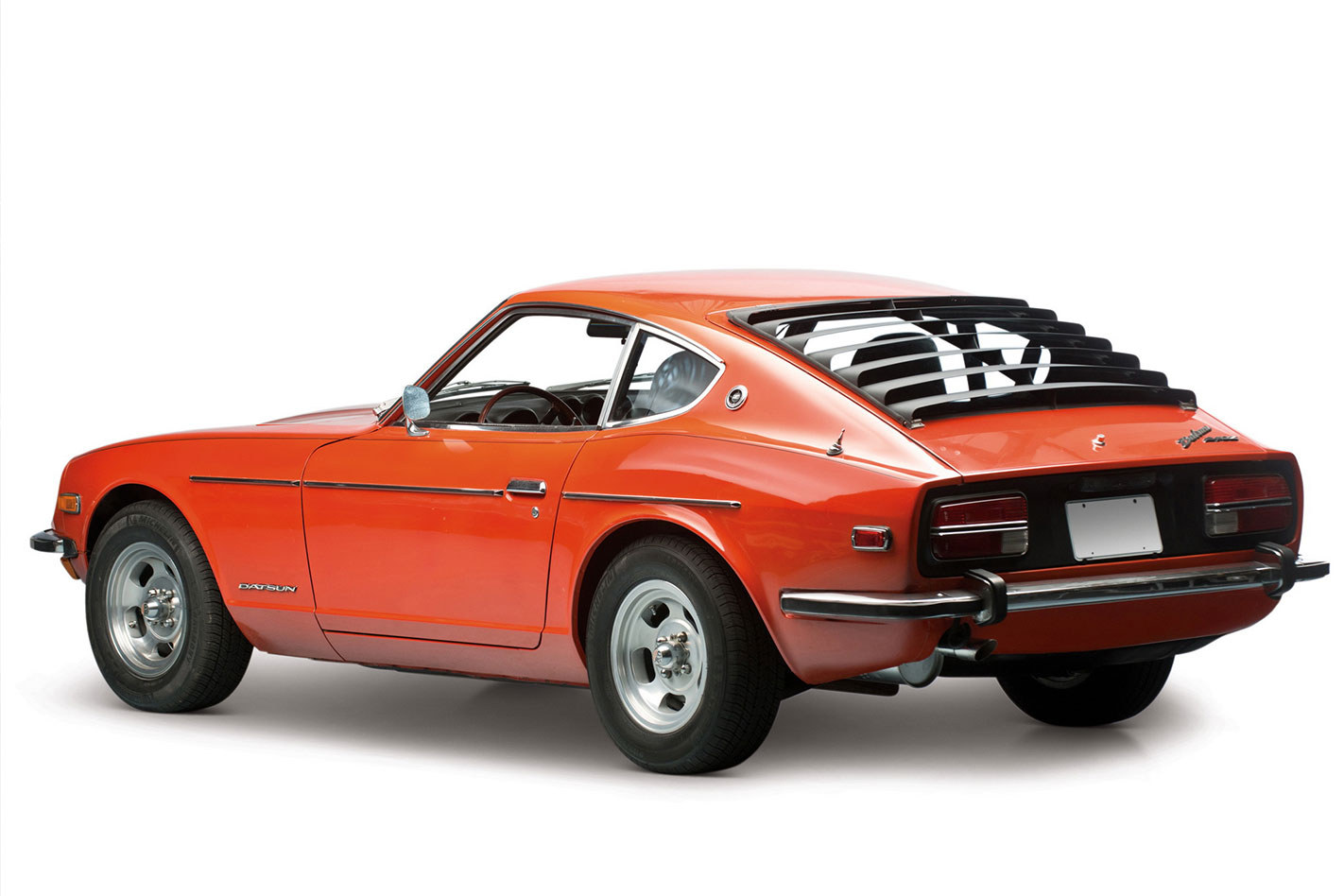
The similarities didn’t end there. It sold amazingly well for a Japanese car in its early years before being succeeded by heavy, luxury-focused flops. The twin-turbo 300ZX provided some hope, but Nissan didn’t pay the original car justice until the 350Z in 2002, which again boasted two seats, six cylinders, and samurai-precise handling. Nissan then cut the wheelbase and stroked its engine in 2009 to give us the 370Z, before a refresh came in 2013 and the third-generation Nismo Z landed in 2015.
Horsing around: The Mustang’s five-decade journey
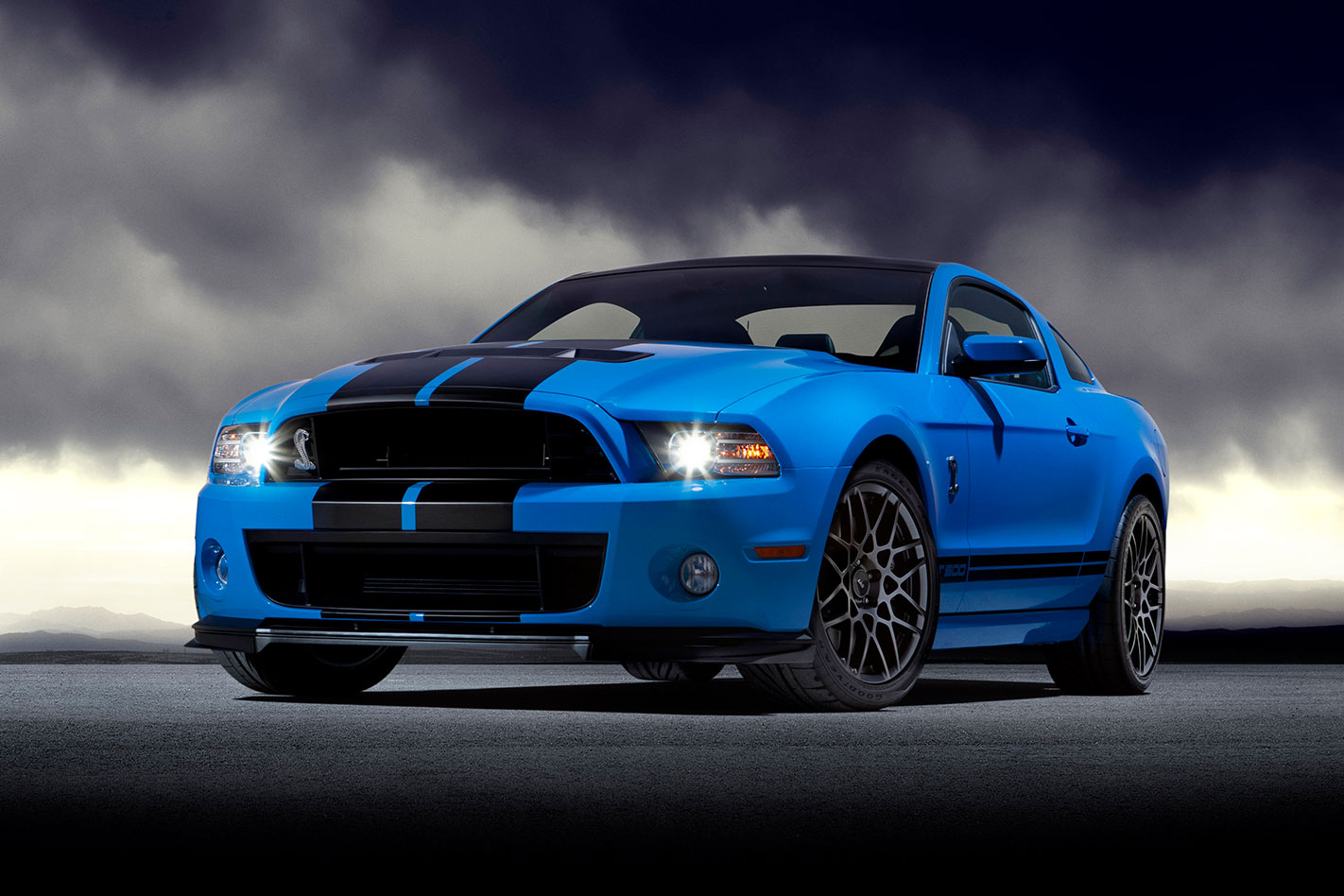
The Mustang II, which debuted in 1974, would have struggled to tail today’s Holden Spark down a drag strip. Thanks to the fuel crisis, there wasn’t even a V8 option until a year after its launch.
Then, in 1979, not only did generation three look nothing like the original, its downsized 4.2-litre V8 couldn’t push its 0-60mph times under 10 seconds.
Power was less of an issue for the next two models than dynamics. A live-axle persisted under the fourth and fifth generation cars, and so did a shoddy ride and questionable rear lateral grip.
Generation five marked the most significant push towards something worthy. Its styling was a faithful throwback and during its lifecycle Ford plugged it with serious firepower. The 2013 Shelby GT500 made 662hp (493kW). No succeeding generation has sold like the original, but the latest one has the best chance being built in both hooks.
u00a0 | FORD MUSTANG GT | NISSAN 370Z NISMO |
BODY | 2-door, 4-seat coupe | 2-door, 2-seat coupe |
DRIVE | rear-wheel | rear-wheel |
ENGINE | 4951cc V8, DOHC, 32v | 3696cc V6, DOHC, 24v |
BORE/STROKE | 92.2 x 92.7mm | 95.5 x 86.0mm |
COMPRESSION | 11.0:1 | 11:1 |
POWER | 306kW @ 6500rpm | 245kW @ 7000rpm |
TORQUE | 530Nm @ 4350rpm | 363Nm @ 5200rpm |
POWER/WEIGHT | 176kW/tonne | 167kW/tonne |
TRANSMISSION | 6-speed manual | 6-speed manual |
WEIGHT | 1739kg | 1467kg |
SUSPENSION (F) | struts, anti-roll bar | A-arms, dampers, anti-roll bar |
SUSPENSION (R) | multi-links, anti-roll bar | multi-links, dampers, anti-roll bar |
L/W/h | 4784/1916/1381mm | 4330/1870/1555mm |
WHEELBASE | 2720mm | 2550mm |
TRACKS | 1582/1655mm (f/r) | 1599/1580mm (f/r) |
STEERING | electrically-assisted rack-and-pinion | hydraulically-assisted rack-and-pinion |
BRAKES (F) | 380mm ventilated discs, 6-piston calipers | 355mm ventilated discs, 4-piston calipers |
BRAKES (R) | 330mm ventilated discs, single-piston calipers | 350mm discs, 2-piston calipers |
WHEELS | 19.0 x 9.0-inch (f); 19.0 x 9.5-inch (r) | 19.0 x 9.5-inch (f); 19.0 x 10.5-inch (r) |
TYRE SIZES | 255/40 R19 (f); 275/40 R19 (r) | 245/40 R20 94W (f); 285/35 R19 96W (r) |
TYRE | Pirelli P Zero | Dunlop SP SPORT MAXX GT 600 |
PRICE AS TESTED | $57,490 | $61,990 |
PROS | Noise; looks; stopping power | Grip; gearshift; involvement |
CONS | Lack of steering feedback; body control; sheu2019s heavy | Terrible ride; dodgy acoustics; silly cabin quirks |
RATING | 4/5 | 3.5/5 |


